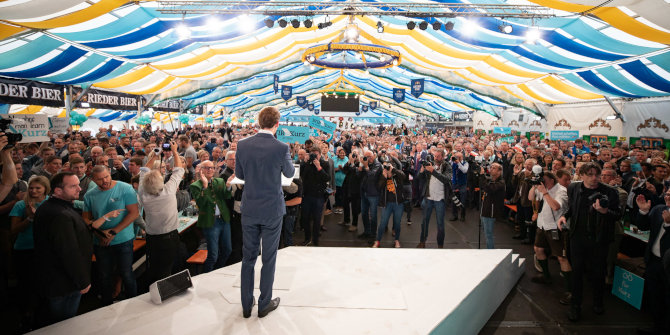 The new Five Star Movement/Lega government in Italy is one of the most ideologically diverse governing coalitions in the country’s history. Mattia Guidi writes that there is great uncertainty over whether the government can keep its many promises to the Italian electorate, and even greater uncertainty over whether the two parties will be able to continue to work together despite their ideological differences.
The new Five Star Movement/Lega government in Italy is one of the most ideologically diverse governing coalitions in the country’s history. Mattia Guidi writes that there is great uncertainty over whether the government can keep its many promises to the Italian electorate, and even greater uncertainty over whether the two parties will be able to continue to work together despite their ideological differences.

Giuseppe Conte and Sergio Mattarella on 31 May, Credit: Presidenza della Repubblica (Public Domain)
The weeks leading to the formation of the new Italian cabinet looked like a soap opera: love declarations, fights, plot twists. Just one week ago, the Five Star Movement leader Luigi Di Maio went on TV threatening to initiate an impeachment procedure against President of the Republic Sergio Mattarella − let us remember that impeachment equals an accusation of “high treason” or an “attempt against the Constitution” − for his refusal to appoint an openly Eurosceptic Minister of the Economy (the 82-year-old Professor of Economics Paolo Savona). On Friday 1 June, the government formed by the Five Star Movement and Matteo Salvini’s League was sworn in.
What changed in those five days? First, the awful performance of the Italian stock market and government bonds (which reached on Tuesday the highest interest rates since 2013) certainly contributed to softening the two parties’ stance. Second, President Mattarella’s intention to appoint a caretaker government would have led to a snap election in the middle of the summer. An election with a storm on the financial markets, and with an all-time low turnout was not really attractive for anyone. Even though the Five Star Movement and the League might have obtained a new popular mandate in a new election, the country could have been in ruins by then. So they went back to Mattarella accepting the replacement of Paolo Savona with a less contested (and less Eurosceptic) Minister of the Economy (another Economics Professor, Giovanni Tria), and that was basically enough.
What can we say of the self-proclaimed “government of change” before it actually begins its policy-making activity? It undoubtedly starts off with a strong popular mandate, but there is great uncertainty as to whether the executive can keep its many promises. The programme that the Five Star Movement and the League agreed upon is full of costly reforms (a lowering of the retirement age, a huge cut to income taxation, a basic income for the unemployed and pensioners amounting to 780 euros per month, to name just the most important ones) that would require more taxes or lower expenditure of more than 100 billion euros per year. The optimism with which most voters look at the new government is due to the fact that practically everyone has been promised some economic improvement. But can this be delivered? It is obvious that some promises will not be implemented, some will be only partly implemented, and the government will soon have to discuss how to cover the huge costs of its programme. The inevitably hard choice between alternatives could shake the strange coalition.
On many issues − like infrastructure, environmental protection, migration − the two parties have opposite positions that will not be easy to reconcile. So far, the impression is that the League, which has been in power for many years in the last three decades and has a much clearer ideological profile, was better than the Five Star Movement in imposing its issues on the agenda. The League’s ministers are also more experienced than those of the Five Star Movement, none of whom had any responsibility of this kind previously. A final, huge unknown is Prime Minister Giuseppe Conte. So far, he has been careful in showing his loyalty to the two political leaders that selected him, but his role will require him to show some leadership, sooner or later. In general, it is very difficult to make predictions about the future interactions between, on the one hand, Conte and the other non-political ministers and, on the other, the party members in the government. This is the first experiment (at least in Italy) of a government with such “mixed” membership.
The cabinet composition appears a compromise not only between the two parties, but also between the powerful anti-establishment posture of the League and the Five Star Movement (probably the only strong ideological link between them) and President Mattarella’s concerns about the country’s position in European and international affairs. To grasp this tension, it is enough to look at the choice of the Minister of the Economy and the Minister of Foreign Affairs. The appointment of Giovanni Tria instead of Paolo Savona, as I mentioned above, is meant to reassure European partners about Italy’s commitment to stay in the euro area. Not surprisingly, after he was sworn in, he tweeted that “no political party in Italy wants to exit from the euro”. Similarly, the appointment of Enzo Moavero Milanesi (Mario Monti’s chief of staff at the DG Competition in the 1990s, and Minister of European affairs in the Monti and Letta cabinets) as Foreign Minister is a way to reaffirm Italy’s role in the EU and NATO.
Will these appointments be enough to avoid tensions? Will the different ‘building blocks’ of the cabinet be able to cooperate? Currently, we can only note that the strange mix appears to be a recipe for tensions. If the parties supporting the government do not moderate their positions and soften their demands, clashes will be inevitable. Finding out who will win and who will lose is a more difficult question to answer.
Please read our comments policy before commenting.
Note: This article gives the views of the author, not the position of EUROPP – European Politics and Policy or the London School of Economics.
_________________________________
 Mattia Guidi – Scuola Normale Superiore
Mattia Guidi – Scuola Normale Superiore
Mattia Guidi is an Assistant Professor in the Department of Political and Social Sciences at Scuola Normale Superiore.





